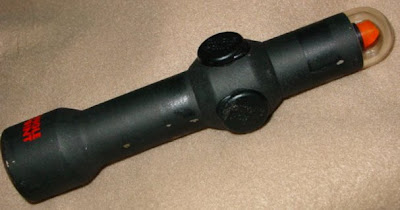The why of the scout rifle
The point of a scout rifle is its versatility. It will do, fairly well at least, as a mountain rifle, plains rifle, brush gun, camp gun, ranch rifle or tactical carbine. There are various rifles that will do any one of these things better, but that is not the point. The point is to get away from specialization, of the kind that requires a safe full of rifles. The scout rifle's lack of extraordinary ability in any area is compensated somewhat by the user's greater familiarity with it, if he really does use it as intended, using it for everything, instead of dividing his time among a collection of rifles. "Beware the man with one gun."
That is the matter as I understand it. The scout rifle concept would catch on quicker if there weren't all those millions of lever .30-30's already out there, giving good service. For a long while the lever gun was the most versatile light rifle going, and in some minds it still is. It is a hard sell to convince the .30-30 man that he needs something better. He fills his game tags just fine with the lever action, and so did his father and grandfather. Any number of bad men have been run off with the old gun, or something worse happened to them. As a utility rifle around ranch or farm, and as a camp and cabin gun, it has been a favorite for a long time because of its handiness and reliability.
To sum up my thoughts on how the two guns compare, the lever gun is quicker, though its advantage can be reduced somewhat if the bolt gunner is well practiced and understands fast bolt work. The scout wins in range, power, accuracy and speed of reloading. (All the currently offered factory-built scouts, Steyr, Savage and Ruger, load with detachable magazines.)
To me the important difference is you get more reach--useful range--with a .308 bolt gun, due to its flatter trajectory, improved downrange energy and (usually) better accuracy. The .30-30 is perhaps the greatest woods and brush gun of all, but is not at its best for longer shots.
Another gun getting in the way of scout rifle sales is the AR-15. It is vastly popular, and deservedly so. It is light to carry. Its excellent ergonomics and light recoil make it easy to shoot and its accuracy is usually very fine. Here what the scout can boast of is more power, pure and simple. It cannot boast about its rate of fire.
The AR-15's .223 cartridge is decidedly substandard for hunting game larger than medium-small, and in many jurisdictions is not allowed for the purpose. The great variety of loadings for the.308 cartridge makes the scout vastly more versatile afield. There are varmint loads for the .308 but no moose loads for the .223. So while the AR-15 may be the best thing ever for rural pest control and has few equals as an urban carbine, it may be criticized for its small caliber.
Rapid firing for close range personal defense is a very strong suit for the AR-15 and it is the scout rifle's weakest area. I would rate the .30-30 somewhere in between the two, for this use; it is better balanced and shaped for snap shooting than the AR-15 but cycles slower and kicks more.
The scout comes in last of the three. But the scout is not useless, by any means, for fast close shooting. Learning the "Tommy finger" technique may add to your confidence in the scout for close quarters use. The "goblin cap" accessory is helpful for aiming. Though the scout comes in last for this particular use, it will do some other things neither of the other rifles does satisfactorily. Other lightweight, compact rifles can be compared to the scout with similar results--better in some ways, but not in all ways. Of course! That's the idea.
Rapid firing for close range personal defense is a very strong suit for the AR-15 and it is the scout rifle's weakest area. I would rate the .30-30 somewhere in between the two, for this use; it is better balanced and shaped for snap shooting than the AR-15 but cycles slower and kicks more.
The scout comes in last of the three. But the scout is not useless, by any means, for fast close shooting. Learning the "Tommy finger" technique may add to your confidence in the scout for close quarters use. The "goblin cap" accessory is helpful for aiming. Though the scout comes in last for this particular use, it will do some other things neither of the other rifles does satisfactorily. Other lightweight, compact rifles can be compared to the scout with similar results--better in some ways, but not in all ways. Of course! That's the idea.


Comments
Post a Comment